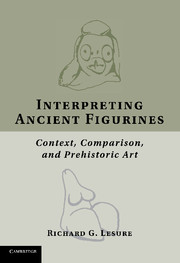Book contents
- Frontmatter
- Contents
- Figures and Tables
- Acknowledgments
- Introduction
- One Universalist Explanation and Prehistoric Figurines
- Two Comparison and Context
- Three The Questions We Ask of Images
- Four A Cross-Cultural Explanation for Female Figurines?
- Five Mesoamerican Figurines and the Contextualist Appeal to Universal Truths
- Six Figurines, Goddesses, and the Texture of Long-Term Structures in the Near East
- Seven On Figurines, Femaleness, and Comparison
- Notes
- Bibliography
- Index
Four - A Cross-Cultural Explanation for Female Figurines?
Published online by Cambridge University Press: 01 March 2011
- Frontmatter
- Contents
- Figures and Tables
- Acknowledgments
- Introduction
- One Universalist Explanation and Prehistoric Figurines
- Two Comparison and Context
- Three The Questions We Ask of Images
- Four A Cross-Cultural Explanation for Female Figurines?
- Five Mesoamerican Figurines and the Contextualist Appeal to Universal Truths
- Six Figurines, Goddesses, and the Texture of Long-Term Structures in the Near East
- Seven On Figurines, Femaleness, and Comparison
- Notes
- Bibliography
- Index
Summary
Could there be a general cross-cultural explanation for the making of female figurines by prehistoric peoples? We considered a specific suggestion along these lines in Chapter 1. The results were not encouraging, although the effort got us out from among the “trees” of prehistoric figurine making in the Mediterranean and Mesoamerica. From a worldwide perspective, it became apparent that trees were clumped into “forests” of considerable spatial and temporal scope and that the forests were few in number.
Still, there were at least four deep-prehistoric cases. In each case, figurines have regularly been identified as female. Universalism-as-usual would examine those cases to see what they have in common. We might then declare any commonality to have “caused” the making of female figurines. Yet, there are many plausible causes for image making, with no accepted means of sorting among them. Any commonality found will be heavily laden with theory and likely impervious to falsification. Moreover, the as-usual approach distracts attention from the possibility that there may be no common explanation by ostentatiously debating what the best explanation (now assumed to exist) might be. It is no wonder that there are those who reject cross-cultural explanation altogether.
My goal in this chapter is something else: As an experiment in holistic archaeology, I put contextualist method to work in the service of universalist explanation. The idea is to build a synthesis of patterning midway between “evidence” and “interpretation.”
- Type
- Chapter
- Information
- Interpreting Ancient FigurinesContext, Comparison, and Prehistoric Art, pp. 68 - 111Publisher: Cambridge University PressPrint publication year: 2011



